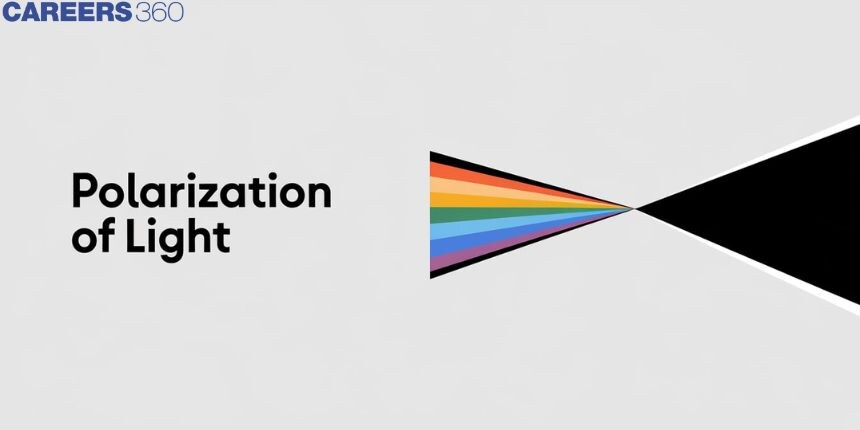Polarization of Light - Definition, Types, Applications, FAQs
Polarization of light is the act of arranging radiation waves so that they oscillate in a single direction only. In general terms, light waves are free to vibrate in any direction while polarized light waves only vibrate in one specific plane or direction. Polarization is used in different applications including designing of sunglasses that reduce glare, enhancing photography, and investigating of properties of different materials. Read the below article for a better understanding of the polarization of Light.
This Story also Contains
- What is Polarization of Light?
- Types of Polarization of Light
- Methods Used in the Polarization of Light
- Applications of Polarization of Light

What is Polarization of Light?
Polarization of light refers to the alignment of the light waves so that they vibrate in a single direction. Light waves normally osciilate in all directions as they move. But when the light is polarized, these vibrations are restricted to one direction only thereby making the light very much organized.
Mathematical Representation of Polarization of Light
If a light wave is linearly polarized along the $x$-axis, its electric field $\mathbf{E}$ can be written as:
$$
\mathbf{E}=E_0 \cos (k z-\omega t) \hat{i}
$$
Where:
$E_0$ : Amplitude
$k$ Wave number
$\omega$ : Angular frequency
$t$ : Time
$\hat{i}$ : Unit vector along the $\boldsymbol{x}$-axis
Also read -
Types of Polarization of Light
Depending upon transverse and longitudinal wave movement, the polarization of light is classified into three types.
- Linear polarization
- Circular polarization
- Elliptical polarization
Linear polarization: A linearly polarized light wave means that the electric field vibrates in a certain linear direction perpendicular to the wave axis, and the magnetic field vibrates in a direction that is perpendicular to both, the advancement axis and direction of the electric field.
Circular polarization: It is the type of polarization in which at every point, the electromagnetic field has a constant magnitude, but its direction rotates with a constant value in a plane perpendicular to the direction of the wave.
Elliptical polarization: It is the type of polarization where the tip of the electric field vector defines an ellipse in any fixed plane traversing, as well as is normal to the direction of propagation.
Methods Used in the Polarization of Light
There are a few methods used in the polarization of light:
Polarization by Transmission: This method utilizes Polaroid sheets which only allow vibrations in one direction to pass through.
Polarization by Reflection: When unpolarized light is reflected at Brewster's angle, the reflected light is Polarized light.
Polarization by Scattering: Scattering of light in the atmosphere can cause partial polarization.
Polarization by Refraction: Light is passed through certain crystals (like calcite or quartz) and splits into two beams with perpendicular polarization directions (birefringence).
Applications of Polarization of Light
- It is used in the production of mirrors that reduce light.
- In many industries, polaroid filters are used for pressure analysis in transparent plastics.
- In the field of entertainment, telecommunications or 3D film screening, light separation is used.
- Outdoor cutting, Fishers. Skiers, motorists, and athletes need special sunglasses. In the manufacture of these special sunglasses, polarization is used.
- It is used in antenna for Radio and satellite signals.
- Polarization microscopes are used in geological studies to identify minerals.
- To study the physics of the first universe, the division effect is applied.
- Helps in knowing the source of radiation and its distribution.
- To determine the distribution of stress in prototypes, polarization is used.
- Used in eye care, to eliminate the strong reflection from the patient's cornea, light isolation is used.
Frequently Asked Questions (FAQs)
It means that the light emitted by the sun travels in all the given directions, i.e. on different polarized lights. And when it is transmitted over a distance, it has a slight separation, and is separated only when its measuring angle is equal to the angle of separation. Because sunlight is everywhere, it is said that light is not polarized. When uninterrupted light falls on an exposed surface with an incident angle equal to the angle of division of the earth or also called Brewster's angle, it is called polarized-polarized. When uncollected light is transmitted through a separating sheet, it is separated.
The different types of segregation are:
- Electronic separation: The transition that takes place in dielectric and mineral materials between positive charge and negative charge results is electronic separation.
- Line separation: Means light is limited to only one plane of polarized light.
- Spatial charge separation: This means the collection of charges on electrodes and on the interface.
- Ionic Separation: Occurs in dielectric metals with atomic bonds between them.
Separation is also possible by re-emitting light. Procrastination occurs when light rays pass from one information to another. On top of these two things, the path of the pole changes where it goes. The pointed beam receives a certain degree of separation.
If light strikes an interface so that there is a 90-degree angle between the reflected and refracted rays, the reflected light will be linearly polarized. The special angle of incidence that produces a 90-degree angle between the reflected and refracted rays is called the Brewster angle.
Polarisation angle is the angle at which unpolarized light or other electromagnetic radiation must be incident upon a nonmetallic surface for the reflected radiation to acquire maximum plane polarization.